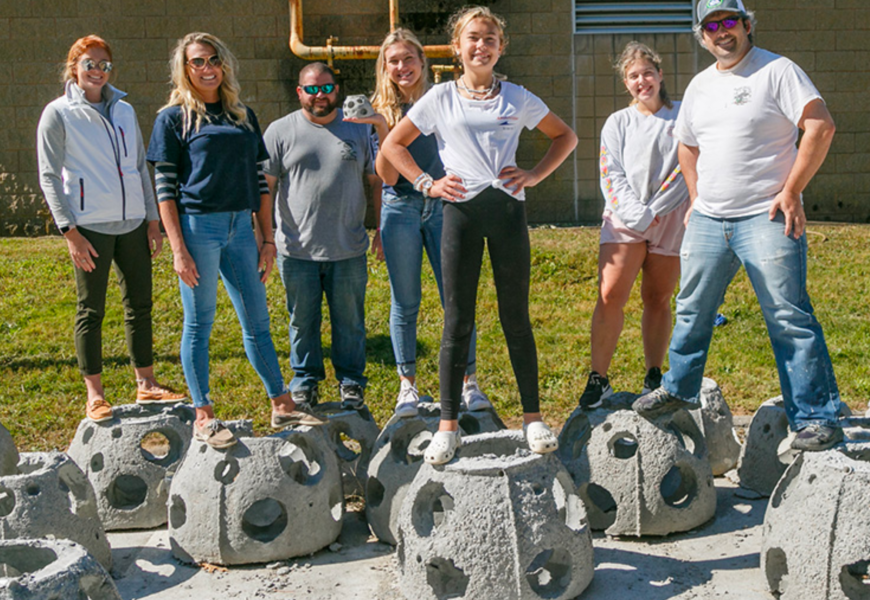Photo Courtesy of Connecticut College
On Oct. 30, 2021, Connecticut College placed thirty reef balls into the Thames River on the College’s waterfront. In the year following the deployment, one hundred and twenty more reef balls have been placed into the Thames.
These concrete, holed balls create artificial reefs and have been placed for the purpose of creating habitats for fish and other marine species according to the College’s website. Additionally, the reef balls help prevent erosion by minimizing wave activity and allowing for the growth of native plants on the shoreline. “Reef balls create a buffer to wave activity, including boat wake action, which can cause millions of dollars in damage to docks and boats in the water,” said Rosa, in an interview with the College.
The project of placing reef balls into the College’s waterfront has been proposed and led by Dr. Maria Rosa, the George & Carol Milne Assistant Professor of Biology at the College. Rosa joined Conn in 2018 and when she began taking students to the waterfront, they quickly noticed the waterfront had a “huge erosion problem” according to The Day.
As a result, Rosa was driven to find a solution for this erosion problem. At first, Rosa wanted to build an oyster reef but found out permitting is difficult. In 2019, Rosa and her students planted eelgrass as it helps minimize wave activity. Unfortunately, swans native to the College’s waterfront ate all the grass planted.
Around the same time, Rosa happened to stumble upon the idea of using reef balls after hearing of Sacred Heart University’s planting of reef balls on the Stratford Point shoreline, according to The Day.
This project began in 2014 and grew into the largest living shoreline in New England, according to Sacred Heart University’s website. Currently, it provides 750 feet of coastal erosion control and an additional 30 feet of habitat.
Inspired, Rosa quickly set about implementing the idea of using reef balls. Though Sacred Heart’s reef used thousand-pound reef balls, Rosa had neither the budget, nor the resources to do the same. Hence, Rosa set about using smaller, less-costly reef balls.
A $10,000 grant from country musician Kenny Chesney’s grassroots project No Shoes Reefs and their partner the Reef Ball Foundation helped kickstart Rosa’s project, which she titled Camels Reef.
With the aid of the grant, Rosa and a team of students and volunteers were able to construct thirty homemade reef balls on an empty campus parking lot throughout the summer and fall of 2021.
According to the College’s website, this process was done through pouring marine-friendly concrete into a fiberglass mold with inflatable buoys and tetherballs implanted to create holes for water and marine life to pass through. Sand is then added to create a natural surface for marine species. Finally, a layer of sugar water is added to give the reef balls an ideal texture for barnacles.
Following the deployment of the first thirty reef balls, Rosa has been able to secure around $200,000 of funding according to The Day. This money has been spent on purchasing additional reef balls and paying student interns.
Of the many organisms in the river, crabs, blackfish, and menhaden have already been spotted habitating the reef balls, according to an interview Rosa gave to The Day. In this interview, Rosa added that eventually oysters, mussels, and barnacles will all settle on the balls.
In the spring, more monitoring of the reef balls will be done by Rosa, members of Rosa’s first-year marine science methods course, and student interns. This monitoring will include measurements of wave action and sediment level to monitor the level of sediment loss from the shoreline.
The data collected from this monitoring will “help other scientists and conservationists understand how reef balls might best be used in other New England waterways,” according to an interview Rosa gave to the College.
Through data recorded by Rosa given to The Day, the College’s waterfront has already lost four to five feet of shoreline since Rosa’s arrival to the College in 2018.
Eventually, Rosa plans to place more reef balls in the spring and summer of 2023 to continue furthering her efforts to prevent erosion and create a sustainable habitat for marine species.









